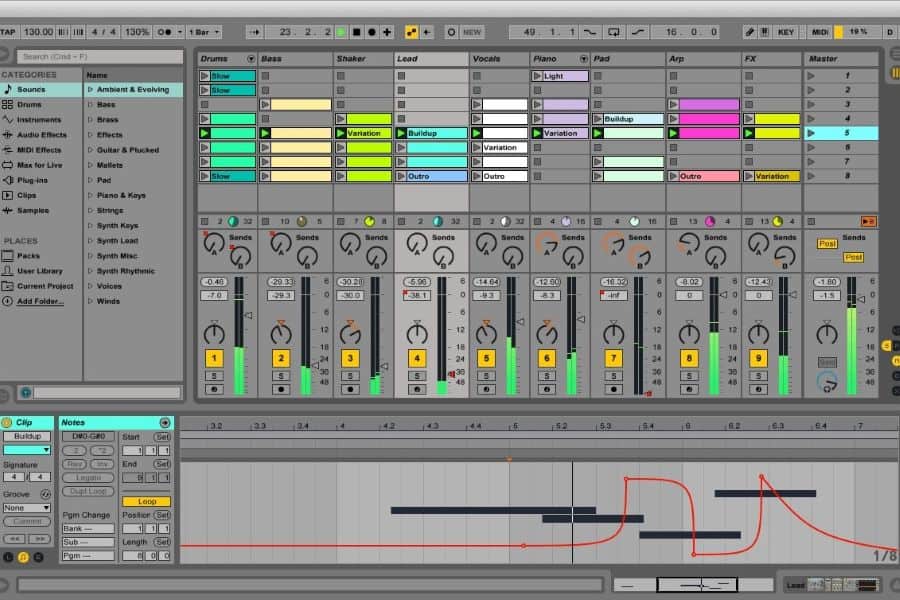Ableton Live is often thought of as a music recording DAW only with its numerous editing and mixing features. Those elements also make it a fantastic option for podcasters.
Before you can put together a file, you’ll need to record the podcast. A few scenarios are available for you to consider.
- You can record directly in the DAW from your soundboard if you’re using a digital mixing console that incorporates USB sound card technology.
- Routing audio from a soundboard to an interface connected to Ableton Live allows for podcast recording.
- You can record a podcast to an SD card before transferring it to the software.
Once you get into a routine, you’ll find that working from a podcast template makes it quick and easy to release new content regularly.
Related: The 11 Best Podcast Editing Software For a Perfect Show
What Is an Ableton Live Template?
Templates on Ableton Live are configured or pre-designed guides that help you create projects quickly.
When using a podcasting template, your content creation process eliminates repetitive tasks within the recording, editing, and mixing process.
Launching Ableton Live for the first time sends you to the default project template. It’s available in the Arrangement or the Session view. You can customize this existing option that loads when launched if you only use the DAW for podcasting.
Here are the steps to follow if you prefer this template option.
- Go to the Live menu, choose Preferences, and get to the File Folder tab.
- You will see the first selection on the screen says, “Save Current Set as Default.” Clicking “Save” will keep whatever changes you made to the original to become the new default.
- Select “Clear” if you need to revert to the previous default template.
The advantage of using this approach is the simplification of your podcasting routine. You no longer need to recreate the same thing for each podcast.
Workflow Templates for Podcasting in Ableton Live
Ableton Live’s workflow templates help you configure flexible sessions while reducing technical tasks and repetition. The default design falls into this category.
The DAW uses the template as a living, evolving structure. It can be constantly changed to fit the current needs of your podcast.
Think about the things that you do repetitively with your work. Are you spending lots of time producing or mixing? Do you see the clock ticking by while mastering?
When you see that many actions are repetitive, you can automate them with hotkeys or incorporate the activities into the template.
You can add several elements to your podcasting workflow template to make life easier. Here are a few examples to consider.
Set the Cue Level
The Cue Level reduces the volume the DAW assigns when opening the template. It affects the samples and clips played through the browser. This feature makes it easier to keep the sounds at the same levels as the podcasting track you’re creating.
Use Group Defaults
You can add default groups to racks or groups of plugins based on your mixing work. If you like to add an EQ or incorporate specific effects, this template option can apply to each group.
This benefit includes adding group defaults for each track. If you want to have specific options assigned to the podcast each time, such as a compressor or a saturator, it can get loaded right away so that you can get to work.
Mapped Keys
If you have repetitive functions, it helps to use the mouse less when working in Ableton Live. The work goes faster when you invest a little time to map some hotkeys.
- You can set it up so that a single keystroke goes to the beginning of the podcast track.
- When mapping goes to the set function, you can tap an assigned key to create a marker at the specified playhead position.
- A global recording button makes it easier to modify your podcasting audio or add new elements to it in the next.
It also helps to have mapped keys that take you between the various markers set for your online podcasting editing and mixing.
What Are the Benefits of Using Ableton Live?
Ableton Live uses an intuitive interface that works well for podcasters, even with limited technical skills.
If you’re unsure if this DAW is right for your podcasts, the trial version of the software contains all the features that come with the paid version. You can experiment with one recording to see if you like it. If not, you didn’t lose much time or money in giving it a try.
The Ableton Live community offers numerous lessons, classes, and tutorials to help get you started. You’ll find that the features and ease of use it provides make it an excellent platform for podcasters to use.
Related: The Best Adobe Audition Alternatives For Your Android Tablet
